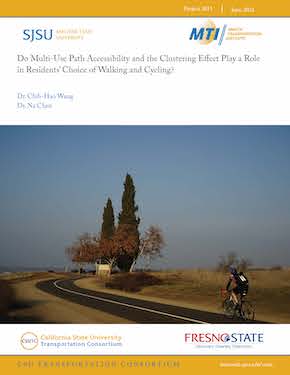- 408-924-7560
- mineta-institute@sjsu.edu
- Donate
Do Multi-Use Path Accessibility and the Clustering Effect Play a Role in Residents’ Choice of Walking and Cycling?
The transportation studies literature recognizes the relationship between accessibility and active travel. However, there is limited research on the specific impact of walking and cycling accessibility to multi-use paths on active travel behavior. Combined with the culture of automobile dependency in the US, this knowledge gap has been making it difficult for policy-makers to encourage walking and cycling mode choices, highlighting the need to promote a walking and cycling culture in cities. In this case, a clustering effect (“you bike, I bike”) can be used as leverage to initiate such a trend. This project contributes to the literature as one of the few published research projects that considers all typical categories of explanatory variables (individual and household socioeconomics, local built environment features, and travel and residential choice attitudes) as well as two new variables (accessibility to multi-use paths calculated by ArcGIS and a clustering effect represented by spatial autocorrelation) at two levels (level 1: binary choice of cycling/waking; level 2: cycling/walking time if yes at level 1) to better understand active travel demand. We use data from the 2012 Utah Travel Survey. At the first level, we use a spatial probit model to identify whether and why Salt Lake City residents walked or cycled. The second level is the development of a spatial autoregressive model for walkers and cyclists to examine what factors affect their travel time when using walking or cycling modes. The results from both levels, obtained while controlling for individual, attitudinal, and built-environment variables, show that accessibility to multi-use paths and a clustering effect (spatial autocorrelation) influence active travel behavior in different ways. Specifically, a cyclist is likely to cycle more when seeing more cyclists around. These findings provide analytical evidence to decision-makers for efficiently evaluating and deciding between plans and policies to enhance active transportation based on the two modeling approaches to assessing travel behavior described above.
CHIH-HAO WANG, PhD
Chih-Hao Wang is an associate professor of the Department of Geography and City & Regional Planning at California State University, Fresno, where he has taught since 2014. He received his PhD (2013) and Master’s (2010) degrees in City and Regional Planning from The Ohio State University. Dr. Wang’s research focuses on environmental planning from the perspective of natural hazard mitigation. Another of his research interests is the application of spatial statistics to the analysis of spatial or social interactions in the earthquake process, as well as water management, transportation planning, and community development. His research has been published in journals in environmental planning, transportation, and geography.
NA CHEN, PhD
Na Chen is an Assistant Professor in the School of Planning at the University of Cincinnati. She received her BA in Public Policy (2008) from Sun Yat-Sen University, Guangzhou, China, her MA in Community Planning and Public Administration (2011) from Auburn University, AL, and her PhD in City and Regional Planning (2016) from The Ohio State University. She then worked as a postdoctoral scholar in the Department of Technology Management at the University of California, Santa Cruz. Her research interests include transportation planning, activity-based travel behavior modeling, accessibility, activity space, transportation equity, land-use modeling, spatial econometrics, and Geographic Information System (GIS) applications for urban planning. Based on her expertise in her areas of interest, Dr. Chen has published many papers in peer-reviewed journals and presented at international conferences.
-
Contact Us
San José State University One Washington Square, San Jose, CA 95192 Phone: 408-924-7560 Email: mineta-institute@sjsu.edu






